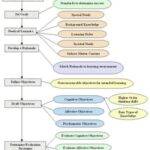Thematic instruction is the organization of a curriculum around “themes” which students can identify with on a daily basis. Thematic instruction is based on the principle that students will learn better when they can connect what they’re learning to the real world. Thematic instruction integrates the core subjects like math, science, and language arts with the exploration of a broad tropic within the curriculum while connecting it to the real world. I have been teaching for the last eight years and until I began this class I had not been exposed to this term. I have actually used thematic instruction strategies without even knowing it. In my experience it has become a positive supplement to my instructional toolbox. I chose to explore this strategy in this essay because I wanted to learn more about how I can further implement this strategy in my instruction.
Summary of Research
Knowledge is constructed through interactions with new ideas and experiences, causing cognitive disequilibrium, which in turn alters conceptual schemata in an individual’s knowledge base. This development is a social process which is referred to as the Sociocognitive Theory. Students who help design their own curriculum engage in the construction of their own knowledge. They learn how to function responsibly in a social learning environment that mirrors the life-long learning environments of the real world (Bruning, 1999). This research clearly supports the relevance of thematic instruction. It does not mention it by name; however, it does state one of the underlying theories behind it.
“The ability to represent knowledge from different conceptual and case perspectives and then, when knowledge must later be used, the ability to construct from those different conceptual and case representations a knowledge ensemble tailored to the needs of the understanding or problem-solving situation at hand” (Spiro, et al., 1991). This is considered the Cognitive Flexibility Theory. Again this theory does not specifically name the thematic instructional strategy, but the theory is a prime example of the application of it. Students who can relate how knowledge transfers across the curriculum through authentic-thematic use of that knowledge have a better chance of retaining that knowledge.
As with any good or exciting strategy, there are always limitations. Thematic instruction, carefully thought-out and correctly applied, can help students make the all important connections between subjects. Contrary to some current thinking, however, not everything needs to be connected. It’s not only acceptable, but sometimes preferable, to stay within the traditional disciplinary boundaries. According to Professor Susan Drake, “It only makes sense to teach through connections”. (Holdren, 1994) We initially believe this to be true, unless the connections don’t make sense. Sometimes thematic instruction is used to push connections beyond what is real and into the land of fantasy. At this point, one is connecting not for the sake of academic reinforcement, but merely for the sake of connecting. Connections that aren’t based on substance but based on entertainment can transform the classroom from a place of learning into a web of unconnected dots.
Analysis
A thematic unit is a directed effort, not a grab bag of loosely connected concepts. With this being said, it will take practice for a teacher to learn how to connect real world themes to the curriculum when it makes sense, not simply for the sake of connecting, or just because it is the “in” strategy for the school year. The thematic instructional strategy is very effective when applied correctly. A teacher must make interdisciplinary connections when logical, natural, and appropriate, but do not completely throw out the core curriculum or the organization of classroom instruction based on that curriculum. Some teachers have experienced these problems with implementing this strategy. It requires a lot of hard, initial design work, plus a substantial restructuring of teacher relationships and class schedules.
Thematic instruction is characterized by a range of distinct strategies. It is a very good supplement to other research-based instructional strategies such as cooperative grouping and generating and testing hypothesis. Thematic instruction should be seen as one among many pedagogical tools, not the only or right way to organize instruction. It should complement, not displace other instructional tools that a teacher possesses.
Conclusion
I have been using thematic instruction in my classroom for years without even knowing it. This was a strategy I developed my first year teaching without any direction or research at all. After reading and analyzing all of the research, I feel that my implementation strategies have been on the mark and consistent with the research results of the various learned professionals I have studied.
I teach automotive technology to high school students. We are required to integrate math, science, and language arts into our automotive curriculum. I use thematic instructional strategies when I integrate these core subjects into my instruction. For example, in language arts, my students have to write essays and prepare an oral presentation based on their essay. I allow the students to develop themes for their essays based on their experiences in the automotive industry or with automobiles. After these assignments are completed, I continue to use their themes and research throughout the year as I am teaching different elements of the curriculum. I know that by applying student developed themes to my core curriculum, I know I have a lesson based on what is interesting to them and it is something they can relate back to their everyday lives.
Resources
Bruning, R.H., Schraw, G.J., Ronning, R.R. (1999). Cognitive psychology and
instruction. Englewood Cliffs, NJ: Merrill.
On Purpose Associates, (2001). Thematic instruction. Retrieved April 22, 2008, from
Funderstanding Web site: http://www.funderstanding.com/thematic_instruction.cfm
Spiro, et al. (1991). Cognitive flexibility, constructivism, and hypertext. Educational
Technology.
Holdren, J (1994).Is “interdisciplinary” better? The limits of thematic instruction.
Common Knowledge. 7.



